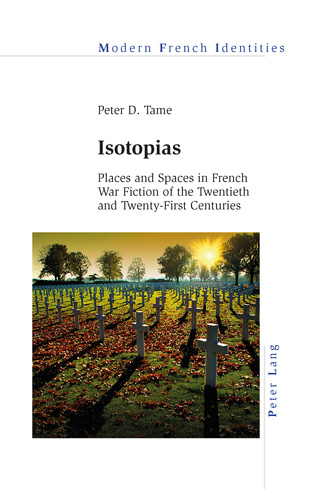 |
Isotopias: Places and Spaces in French War Fiction of the Twentieth and Twenty-first CenturiesVon Peter D. Tame2015 | Peter Lang (externe Seite) Exemplar verfügbar: Ja Sprache: Englisch Seiten: 584 ISBN: 978-3-0343-0837-3 Über das Buch This monograph is the first book to examine places and spaces in French war fiction of the twentieth and twenty-first centuries. These places and spaces are presented as literary isotopias, or fictional «worlds», and analysed in a selective corpus of thirty-three novelists and forty-two examples of war fiction. The book identifies and classifies the various types of isotopia that appear in fiction in the form of scenes, images or literary microcosms. The author establishes four isotopic modes – possession, dispossession or loss, alienation, and repossession – by which means the isotopias are expressed. The spaces considered include territorial demands, gains, possessions, losses and national spaces, as well as internal mental spaces. Contents: Roland Dorgelès, Les Croix de bois (1919): Memotopia of martyrdom – Raymond Radiguet, Le Diable au corps (1923): Egotopia and erotopia – André Chamson, Roux le bandit (1925): Rurotopia and sacrotopia in the Cévennes – Jules Romains, Prélude à Verdun (1937) and Verdun (1938): Les Hommes de bonne volonté(1932-1947) – Jean Giraudoux, Siegfried et le Limousin (1922): Amnesotopia – The effect of war on individual memory in peacetime – André Chamson, L’Année des vaincus (1934): A Franco-German utopia/dystopia? – André Malraux, L’Espoir (1937): The Spanish Civil War, as a preliminary to the Second World War – Robert Brasillach, Les Sept Couleurs (1939): A rainbow too far – European Fascism and a divided France – On the margins: Julien Gracq, Un Balcon en forêt (1958) – Oneirotopia in conflict and wartime – France violated: Irène Némirovsky, Suite française ([1941/1942] 2004) – The labyrinth of defeat: Claude Simon, La Route des Flandres (1960) – The rape of eastern Europe: Jonathan Littell, Les Bienveillantes (2006) – the Nazi occupation in Soviet Russia, France, Hungary, Poland – Sweet Occupation? Suite française Part II «Dolce» – Irène Némirovsky’s novel on the German occupation of France – East and West: Political isotopias in André Malraux’sLes Noyers de l’Altenburg (1943) – The dark, dystopian night-time of the soul: André Chamson’s Le Puits des miracles (1945) – The conquest of a contested colonial space revisited: Robert Brasillach’s La Conquérante(1943) – Jean Dutourd, Au bon beurre (1952): A ‘cornutopia’ – Profiteering in Occupied France – France 1945: A space under reconstruction in Marcel Aymé’s Uranus (1948) – Ecotopia in Romain Gary’s Les Racines du ciel(1956) – Isotopias in invented autobiography: Four novels on the Occupation by Patrick Modiano. |



